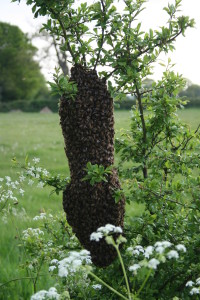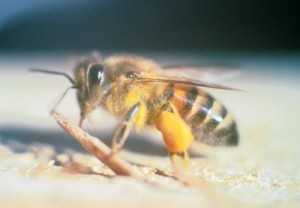[hr]
How is Granny Doing?
From the most recent reports it appears this 71-year-old woman is expected to recover.
When the firefighters arrived on scene they reported that it looked like she was wearing a bee suit. This resulted in over 1,000 individual bee stings.
The colony of approximately 75,000 “killer bees” had made their home in a fiber optic phone line utility box. According to an unnamed insect removal expert consulted by ABC these boxes are supposed to be “bee proof”. Perhaps a careless utility worker left it partially open.
Five firefighters were taken to the hospital to be treated for stings sustained while saving the woman. They are expected to be okay. A Verizon employee and multiple neighbors were also stung. This was a major Africanized killer bee swarm event.
Unluckily for us the killer bee threat in America is nothing new. The first Africanized bees were found in Southern California in 1985 delivered there by a Venezuelan oil tanker. Then in 1990 they spread into Texas by way of Mexico.

Africanized bees are notoriously more aggressive than the European honeybee that many of us are accustomed to. And the Africanized bee is the primary bee of beekeepers in South America and Central America because they’ve outcompeted other subspecies.
But there is a big fear factor effect when it comes to Africanized bees. The sting of the ‘killer bee’ is no more potent or deadly than any other honeybee.
The danger lies in their easily provoked nature. They’re very territorial and protective of their hives. And when they attack it tends to be relentless and they tend to swarm more violently.
But deaths from Africanized bees are actually rare. Usually 1-2 per year in the United States. But a situation might occur where you could wind up being one of those 1-2 people per year. In 2013 a 62-year old man was killed by a swarm of bees in Moody, Texas.
The Best Defense is Avoidance
When it comes to Africanized bees – or any damn stinging insect – the best solution is avoidance.
Bees usually don’t like being disturbed so they prefer to develop colonies in uninhabited buildings and structures. But it’s also common for bees to build hives inside the eaves of residential homes that are occupied.
Another favorite spot for bee colonies is inside hollow trees. I discovered this personally while in the woods, but got away with only 2-3 stings.
Listening and looking for bee activity is a good practice when you’re out in the woods or poking around outdoor structures. Even a hollow tree in the neighborhood park could house a colony. If you’re attentive their usually easy to spot.
It should be common sense, but if you find a beehive leave it alone. They are easily provoked if you threaten their colony. Remember that hive is their sole source of survival. Without it the whole colony is likely to die.
It’s also advised to avoid fast movement and loud noise. This will also provoke attack.
If you’re unlucky enough to be attacked by a swarm of bees the fast movement rule should be immediately forgotten!
How to Escape a Swarm
Consensus online, and my personally opinion tend to agree on the method of escaping and surviving a swarm of bees.
If you’re being swarmed, RUN. Run fast because bees are not fast flyers and a healthy adult human can easily outrun them. If possible run into the wind because any breeze or wind will slow them down considerably.
Since Africanized bees are known to chase relentlessly up to 50 yards or more it’s best to find sealed shelter quickly. Run into a house or well-sealed structure until the bees leave – it could be a while so sit tight. If you’re out camping your tent should suffice.
It’s not recommended to go underwater because bees are known to wait around and attack when you come up for air. I know you’ve probably seen this technique in cartoons many times.
Also try to protect your face as much as possible while you’re running. Bee stings on the face can cause major swelling. Also don’t swat or flail your arms because they’re attracted to excess motion.
If you got away but still sustained stings you should treat them or seek treatment as soon as possible.
Treating Bee Stings
There are some special considerations when treating a sting from a bee. Lets go over them real quick.
- Remove all the stingers. When a bee stings they leave the stinger lodged in your skin. The venom can continue to enter your body from the stingers if left in.
- Do not pull the stingers out with your fingers or tweezers. The squeezing can release more venom. You want to scrape them out sideways. A finger nail, credit card, dull knife, or other straight-edged object should do the trick.
- If you’ve suffered a substantial amount of stings – 15 or more – you may want to seek medical attention. Also if you’re feeling ill or believe you may be allergic to bee stings you should seek medical attention.
- After removal of the stingers you should control any swelling. Ice, elevation and removing tight fitting clothing and jewelry is a good idea.
- An over-the-counter pain reliever can help relieve the pain. Ibuprofen will also help with swelling. If you’re itching then an antihistamine like Benadryl may be a good idea. There are also many sting relief liquids available at your local pharmacy to keep in your first aid kits.
Of course if you’re experiencing extreme reactions to the bee stings you should call 911. Some of these symptoms are trouble breathing, faintness or dizziness, hives, and or swollen tongue.
Some people are extremely allergic to bee stings. Hopefully you are aware if you are or are not. To prevent anaphylactic shock most people who are highly allergic carry an injection of epinephrine – prescribed by their doctor – with them. This should be injected immediately after a bee sting.
Bees Are Vital to Our Survival
All things considered the honeybee, and it’s evil Africanized cousin aren’t a huge threat to your safety – or to society. With a little care and planning we can all get along.
We can’t eradicate the bees, not even the Africanized killer bees because they perform a very important service to our planet. They pollinate our crops allowing our food to grow.

In fact bee populations are in danger, and are declining. Some scientists think the declining bee populations could be the single greatest threat to the future of our civilization. If you ever have a beehive on your property that you don’t want there please don’t kill them! Call a beekeeper! They would love to remove the bees while keeping the colony intact. We need our bees.
Even though I occasionally get stung by the errant bee I don’t really blame them. They’re just doing what they do. When a wasp stings me … well I’d rather they just didn’t exist at all!
I hope that this information has helped you better prepare for a run in with a swarm of killer bees.
To Your Survival,
Nick Gillick
Have you had any crazy experiences with bees? Ever stumble upon a pissed off hive? I’d love to hear about your exploits in the comments below.
Even better … If you have a good tip for dealing with Africanized bees please share it with the community.
Disclaimer: I am not an expert on bees and treating bee stings. I’ve researched and compiled the best information I could find on dealing with Bees. Medical information was obtained from WebMD.com
